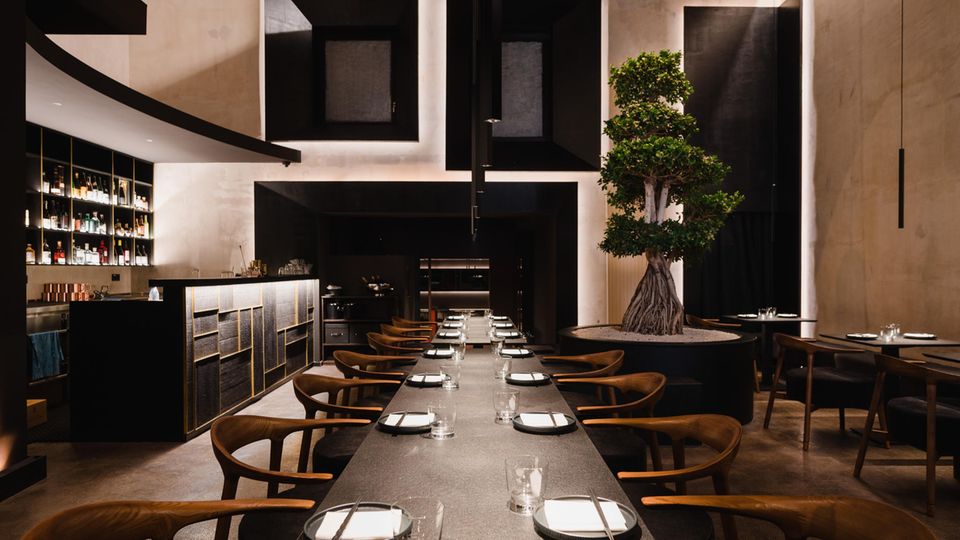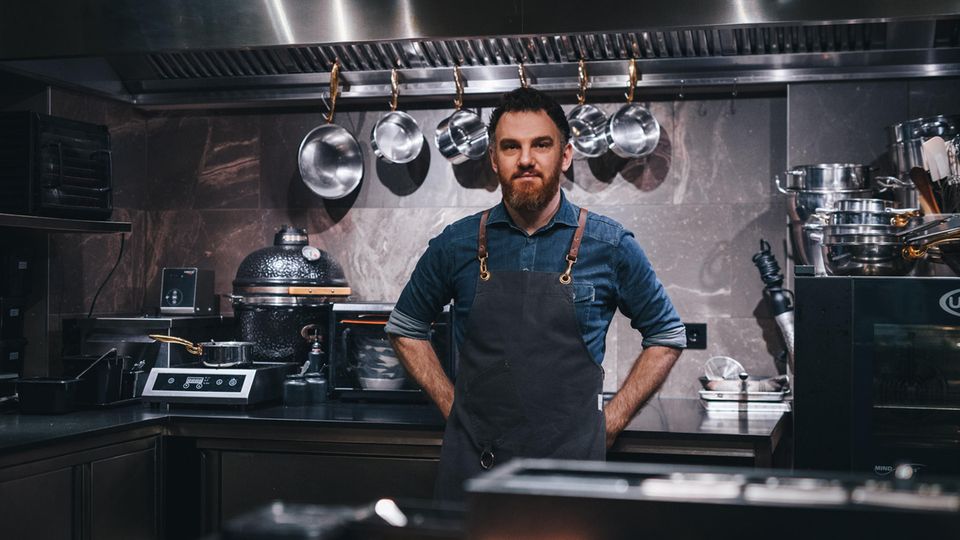Timur Yilmaz has worked in the best restaurants in the world. Now he is shaking up the Berlin gastronomic scene with upscale, vegan cuisine. A conversation about what fascinates him about purely plant-based cuisine – and why he nevertheless enjoys eating gyros in pita bread.
Only those who know where they want to go can find the red door in a backyard in the bustling Mitte district. Here, where the gastronomic scene is vibrant, where hip cafés and trendy restaurants line up, a place of peace has established itself. The restaurant Oukan fascinates the capital’s residents and their guests with upscale, vegan cuisine. The model is Japan, both in the design of the restaurant and in the handling of the kitchen. Chef Timur Yilmaz has cooked in starred restaurants around the world. These include famous names such as the Pujol restaurant in Mexico City (9th place in the 50 best restaurants in the world), the Frantzén restaurant in Stockholm (three Michelin stars) and the Coda restaurant in Berlin (two Michelin stars). At Oukan, Yilmaz focuses on the quality of the ingredients – and on his fermentation laboratory, which is located below the restaurant. There he and his colleague Paul Kaufmann, who worked as a fermenter in the famous Noma, ferment soybeans into soy sauce or miso paste and make vinegar. They want to show their guests how intense the flavor can be achieved even without animal products.
Mister Yilmaz, You were born in Belgium and have German-Turkish roots. Part of your family lives in Italy. Since June 2023, you have been head chef at a vegan restaurant inspired by Japanese cuisine. How does all of this fit together?
It’s an enrichment! At the end of the day, I combine the influences of my childhood and the places I worked in with new ingredients and new techniques.
Her cuisine at Oukan is purely plant-based. This means you don’t use any animal products. Doesn’t that limit you?
On the contrary. On the one hand, I am limited when it comes to using the ingredients. Let’s take leeks as an example: I wouldn’t have been interested in them before, but today I’m thinking for a long time about what I can do with them in the kitchen, other than frying or blanching them. In the end, it’s actually very enriching to only cook plant-based food – it challenges my creativity and stimulates new thought processes and ideas.
You’ve never cooked vegan before, were you discouraged from the job at Oukan?
The chefs I’ve worked with before all told me not to do the job. Vegan cuisine is too restrictive. But my friends who are musicians and artists looked at it from a different perspective – a creative one. They told me that it was great to limit yourself to develop new perspectives. It’s more challenging because I can’t just open a cookbook or find recipes on the internet. I have to rediscover everything.
Can you give an example?
A few years ago I was in Naples and ate raw squid cut into thin strips and dusted with dehydrated ink. In the spirit of a pasta dish. At some point I had these squid noodles in my head again and wanted to recreate them. So I cut the king oyster mushrooms into thin strips and fermented them between kombu seaweed to get a fishy taste. The fungus released salt that really tasted like the sea. There was also a simple sauce and “poor man’s parmesan” on top, i.e. grated breadcrumbs from a brioche bun, which we mixed with home-made koji (editor’s note: koji is a mushroom culture that, among other things, plays an important role in… Making soy sauces or miso pastes). Add some black lime powder for the acidity. And we had one of our favorite dishes: Kombujime Eringi, herb mushrooms with a habanero-koji crumble.

Kombujime Eringi, herb mushrooms with a habanero koji crumble
© Jozefien van der Aelst
That sounds complex.
It’s really nice to get to this point. I don’t think I would have come up with a dish like this without the supposedly limiting creativity.
How often do doubts play a role in the creation of such dishes?
Constant! I’m always skeptical about my cooking skills, I always think something is missing. But I then serve something like this to my friends and colleagues and we try the dishes together with the sommelier and think about which wine or tea could go with it.
You have worked in the top restaurants in the world, for example in the three-star restaurant Frantzén in Stockholm and the two-star restaurant Coda in Berlin. How have these restaurants influenced you?
Above all, they taught me organization. High-end restaurants like Frantzén function like a very well-organized organism. In Coda I learned consistency, perfection and precision. My dishes at Oukan are very minimalistic, almost sober. For me it’s more about the technology – and how you can get the best out of the product. I don’t need millions of components, no tiny little herbs or gel dots. All of this just distracts from covering up the fact that you don’t know how to handle and work with a good product.
Fermentation is a central element in your kitchen: soy sauces, Miso pastes, pickled vegetables. How do you use these products on your plates?
We are very purist and don’t fill our plates with pickled vegetables or pickles. We concentrate on individual components that are added to the dish. Soy sauces, for example, or our own vinegars and miso pastes. There are tools in our kitchen that make a difference in the aroma. Unlike the stuff you can buy in the supermarket.
Their concept is called Japanese inspired. Have you ever had any contact with Japanese cuisine?
It’s less about our cuisine being Japanese and more about cooking techniques that are definitely influenced by Japanese cuisine. Sometimes we have Japanese products to which we apply European techniques – and sometimes we process German products in a Japanese way.

The interior of the “Oukan” restaurant is also Japanese-inspired
© Nils Hasenau
You have a fermentation lab in the basement beneath your restaurant. I immediately think of white cabbage that is fermented into sauerkraut. What does it smell like down there?
It smells wonderful down there right now (laughs) because we’re fermenting a lot of koji. It has a sweet, malty smell. When Paul makes vinegar, it smells stronger. Some processes are short, some take longer. We made a few batches of miso that will be ready in two years.
Her cuisine has influences from all over the world. What does your childhood taste like?
Grilling. My father has a Turkish background, so there was always a lot of grilling. My grandfather always baked, he’s German, and there was a lot of bread and cookies. My mother’s family has roots in Italy, so there was a lot of pasta served.
Did you have a favorite pasta dish?
Yes, when I was five years old my teacher asked me what my favorite dish was. All the children answered lasagna, hamburgers or pizza – and I said spaghetti alle vongole, i.e. with clams. That was very special. (laughs)
What do you eat after a long day at work: Do you still cook at home?
No way. I only eat what can be eaten straight from the bag or jar, for example kimchi.
Do you have a vice?
Gyros in pita bread with French fries.
As a vegan chef?
I never said I was vegan… but I mainly eat vegan.
What do you like better: Turkish mantı or Italian tortellini?
Sorry, Dad. Tortellini definitely.
Your own restaurant – what would it look like?
A counter with 12 to 18 seats, I would prepare the dishes over an open fire and serve them directly to the guests. I wouldn’t take myself too seriously, play good music and just make sure my guests have a good time.



